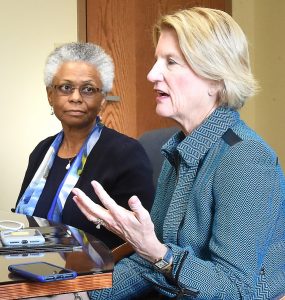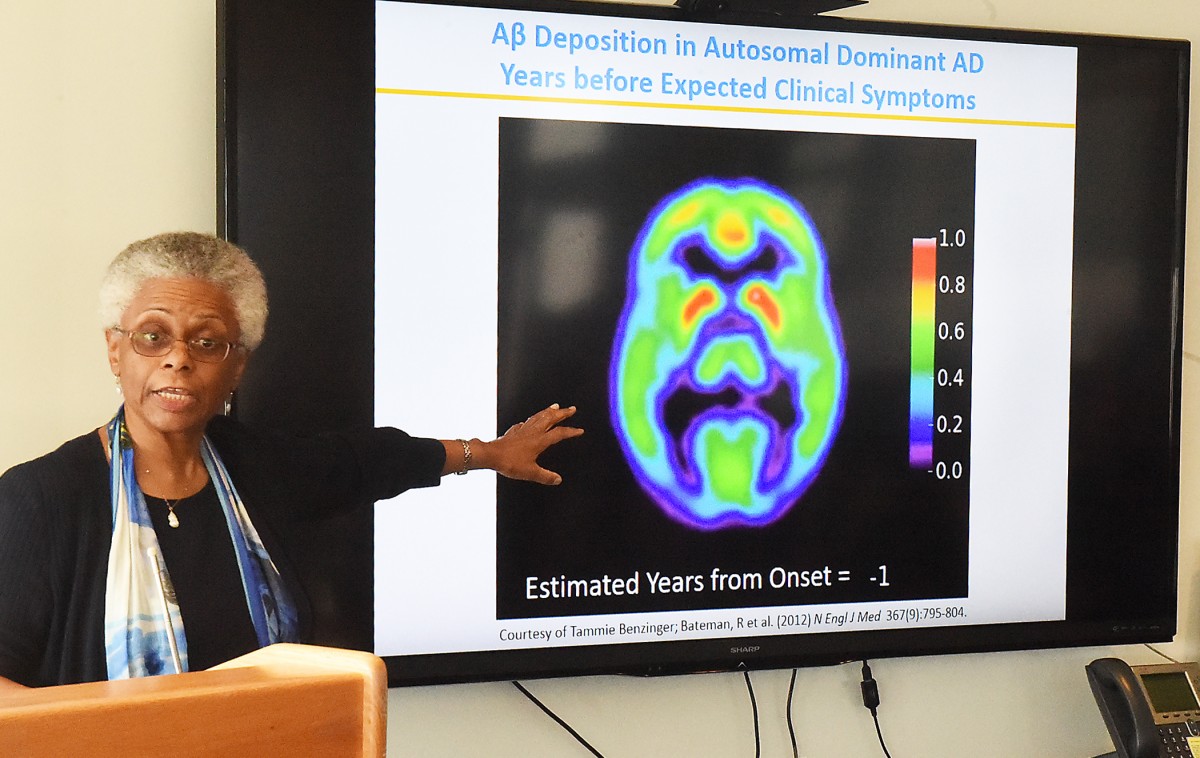MORGANTOWN — Sen. Shelley Moore Capito brought the deputy director of the National Institute on Aging to WVU on Wednesday to give her a look at WVU’s cutting-edge Alzheimer’s research and to give WVU researchers a look at grant opportunities and other projects across the country.

Capito and Dr. Marie Bernard of the NIA — part of the National Institutes of Health — had a sit-down chat before Bernard’s presentation and a tour of the Rockefeller Neurosciences Institute.
People’s passions come from personal experience, Capito said. “My personal experience with Alzheimer’s is what really drives my curiosity and my will to find a cure.” She added later, “Both of my parents went down the terrible hole of Alzheimer’s at the same time.”
Capito’s father, former Gov. Arch Moore, died in 2015; her mother, Shelley Riley Moore, died in 2014.
Bernard explained the increased federal emphasis on finding a cure for the disease beginning with the National Alzheimer’s Project Act of 2011, which set a goal of achieving prevention or a cure by 2025.
That was followed by the Alzheimer’s Accountability Act of 2015, which directed NIH to develop budget projections to take advantage of scientific research opportunities. That budget projection isn’t subject to tinkering, she said. It goes directly to Congress through the president without modification.
“Associated with that, there’s been a really tremendous increase in funding availability for Alzheimer’s projects,” she said.
NIA’s budget tripled from Fiscal Years 2013 through 2019, to $3.08 billion for FY 2019 (Oct. 1, 2018 through Sept. 30, 2019). One of its core focuses is on Alzheimer’s and related dementia research, and that portion of its budget has seen steady increases since FY 2016, with a $425 million boost for FY 2019, to total $2.33 billion.
Capito and Bernard agreed that the escalation of Alzheimer’s and dementia cases is reaching epidemic proportions. Bernard said some projections indicate the cost of Alzheimer’s in 2040 will be more than cost of care for either cancer or cardiovascular disease.
Clay Marsh, vice president and executive dean for WVU Health Sciences, was leading the day’s events and told Bernard that West Virginia has the fourth-oldest per capita population in the nation.
“That makes us even more committed to trying to create the right solutions and have the right partnerships to be able to do this,” he said. “We want to solve the problems of the health of the citizens of West Virginia. But then we want to scale those solutions to the world. We believe we’re in a really unique position to do that.”
After the chat, Bernard and Capito fielded a couple questions from The Dominion Post.
One, is research revealing the cause of the disease?
Bernard said there are a lot of pathways that initiate the disease, among them genetic changes. Advances in the past decade have led from identifying just four genes associated with the disease to more than 30. During that same period, new imaging techniques have been able offer pictures of what happens in the brain.
“From my vantage point,” she said, “my suspicion is we’re going to find out that there are a lot of different ways that one can end up down that last pathway of having Alzheimer’s type dementia.”
The second, why are we seeing such growth in the number of cases?
Capito put it simply, “It’s because we’re living longer.”
Bernard added that the increase in Alzheimer’s cases reflects the successes of medical advances in other areas. “As we’re doing better with that, these sorts of illnesses are becoming more evident.”
Marsh asked if current science offers any clues on prevention.
There’s nothing definitive yet, Bernard said. There is promising but inconclusive data on the benefits of exercise, blood pressure control and cognitive training.
A room full of researchers gathered to hear Bernard talk about hundreds of research projects going on nationwide, and about research grants NIA is offering with its increased budget. She commented on whether the 2025 goal set by the National Alzheimer’s Project Act is truly achievable.
“You don’t know how the science is going to evolve,” she said. “You can’t guarantee, but it’s promising.”
One researcher asked Bernard about President Trump’s proposal to cut NIH’s total budget for FY 2020 from $39.1 billion to $34.4 billion [he has proposed cuts to NIH for several years], and how that might affect Alzheimer’s research.
Bernard bounced that one to Capito, who told the group she serves on the Senate Appropriations Committee and sits on the Health Subcommittee.
Capito explained that the president proposes a budget but Congress appropriates the money. Trump proposed a cut for NIH for FY 2019 but Congress gave it an increase.
“NIH funding will not go down,” she said. “It’s not the will of the Congress.”
It may not increase as much, she said. Everyone should know by June, when the House and Senate expect to have their respective appropriations bills done.
Tweet David Beard @dbeardtdp Email dbeard@dominionpost.com




